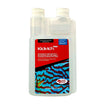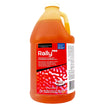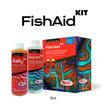- No products in the cart.
A Healthy Aquarium: Effective Strategies For Treating Ich In Reef Tanks
05
Jul

Ich, also known as white spot disease, is one of the most common and persistent issues faced by reef tank owners. This parasitic infection, caused by the protozoan Cryptocaryon irritans, can wreak havoc in a reef environment, affecting both fish and corals. Treating ich in a reef tank requires a delicate balance of effective treatment methods and careful consideration of the sensitive ecosystem. In this blog, we will explore comprehensive strategies for diagnosing, treating, and preventing ich to ensure the health and vibrancy of your reef tank.
Understanding Ich in Reef Tanks
Ich manifests as white spots on the skin, gills, and fins of fish, causing irritation, respiratory distress, and lethargy. In a reef tank, where corals, invertebrates, and other sensitive species coexist, treating ich can be particularly challenging due to the need for reef-safe medications and methods.
Diagnosing Ich in Your Reef Tank
Visual Identification:
Look for small white spots on the fish's body, fins, and gills. Fish may also exhibit signs of stress, such as rubbing against surfaces (flashing) and labored breathing.
Behavioral Changes:
Infected fish may become less active, lose their appetite, and isolate themselves from the rest of the tank inhabitants.
Confirming the Diagnosis:
If you suspect ich, closely monitor the affected fish and observe any spread of symptoms to other tank inhabitants. Proper diagnosis is crucial for effective treatment.
Effective Treatment Strategies for Ich in a Reef Tank
1. Quarantine and Isolation:
Setting Up a Quarantine Tank:
Move the infected fish to a separate quarantine tank. This reduces the risk of spreading the parasite to other fish and allows for more aggressive treatment.
Maintaining Water Quality:
Ensure the quarantine tank has proper filtration, aeration, and temperature control. Regular water changes are essential to maintain optimal water quality.
2. Reef-Safe Medications:
Choosing the Right Medication:
Use medications specifically labeled as reef-safe to avoid harming corals and invertebrates. Copper-based treatments, commonly used for ich, are not suitable for reef tanks as they can be toxic to corals.
Popular Reef-Safe Treatments:
Hyposalinity: Lowering the salinity in the quarantine tank can help eliminate the parasite. Gradually reduce the salinity to 1.009-1.010 specific gravity over 48 hours, and maintain it for 4-6 weeks.
Herbal Remedies: Products like Ruby Reef Rally and Kick-Ich are herbal-based treatments that can be used in the display tank without harming corals and invertebrates.
3. Improving Tank Conditions:
Enhanced Filtration:
Ensure your tank's filtration system is functioning optimally to remove organic waste and reduce stress on the fish.
Oxygenation:
Increase aeration and water movement to enhance oxygen levels, supporting the fish's respiratory system during treatment.
Temperature Control:
Maintain a stable water temperature, as fluctuations can stress fish and exacerbate ich outbreaks. Aim for a consistent temperature around 78-80°F (25-27°C).
4. Nutritional Support:
Boosting Fish Immunity:
Provide a high-quality, varied diet enriched with vitamins and supplements to boost the fish's immune system. Garlic-infused foods are known to enhance immunity and appetite.
Reducing Stress:
Minimize stress by avoiding sudden changes in the tank environment and ensuring a peaceful, stable habitat for the fish.
Preventing Future Ich Outbreaks
1. Quarantine New Additions:
Isolate New Fish:
Always quarantine new fish for at least 2-4 weeks before introducing them to the main tank. This practice helps detect and treat any potential infections before they spread.
2. Maintain Optimal Water Quality:
Regular Water Changes:
Perform regular water changes to keep water parameters stable and reduce the buildup of harmful substances.
Consistent Monitoring:
Regularly test water parameters such as ammonia, nitrite, nitrate, pH, and salinity to ensure they remain within acceptable ranges.
3. Healthy Tank Environment:
Proper Stocking:
Avoid overstocking the tank, as overcrowding can increase stress and the likelihood of disease outbreaks.
Adequate Filtration:
Use a high-quality filtration system suitable for the size and bioload of your reef tank.
Conclusion
Treating ich in a reef tank requires a combination of careful observation, effective treatment, and preventative measures. By promptly diagnosing the infection, using reef-safe medications, and maintaining optimal tank conditions, you can effectively manage and prevent ich outbreaks. Remember, a proactive approach to quarantine and regular monitoring is key to ensuring the health and vitality of your reef tank inhabitants. With diligent care and attention, your reef tank can thrive, showcasing the beauty and diversity of marine life free from the threat of ich.





